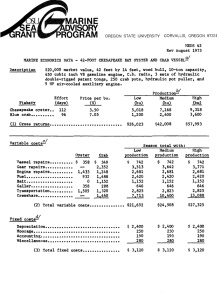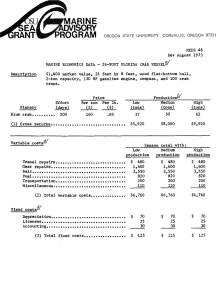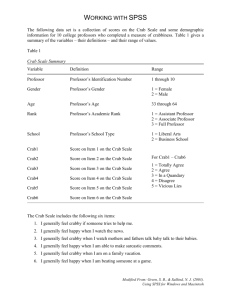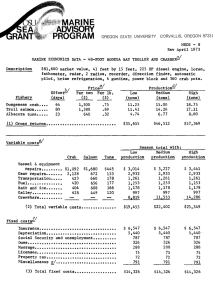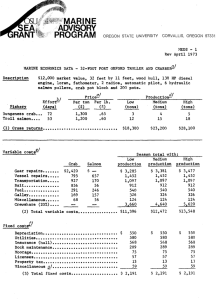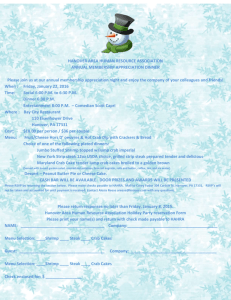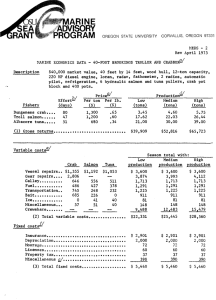Improving the quality of commercially processed Dungeness crab
advertisement
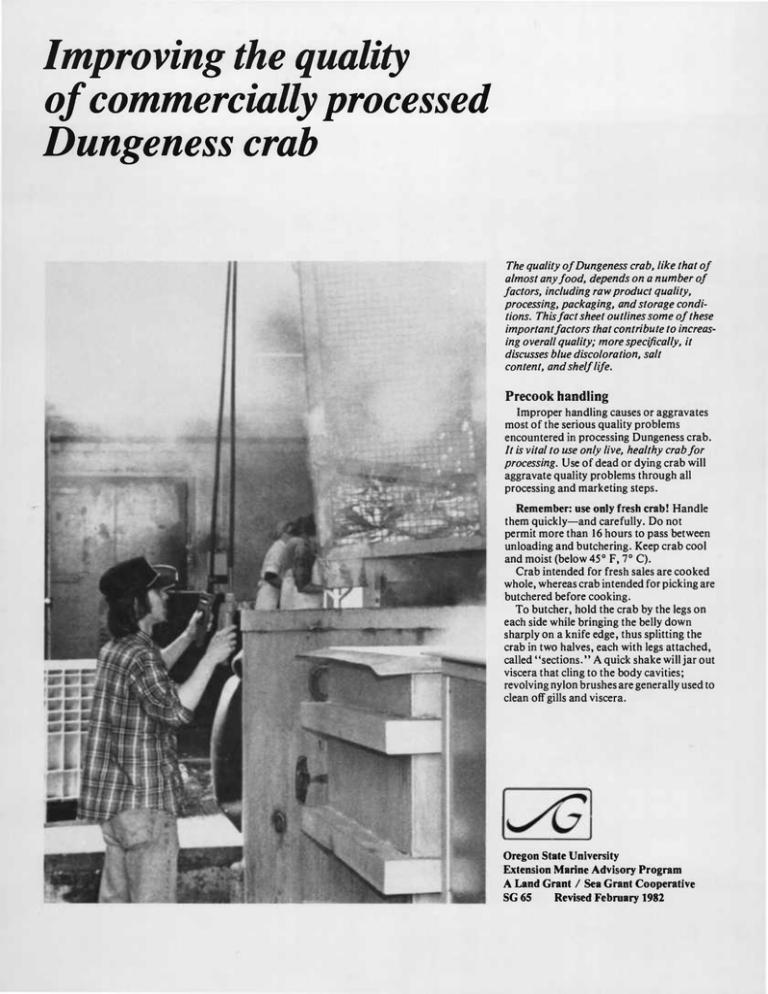
Improving the quality of commercially processed Dungeness crab The quality of Dungeness crab, like that of almost any food, depends on a number of factors, including raw product quality, processing, packaging, and storage conditions. This fact sheet outlines some of these important factors that contribute to increasing overall quality; more specifically, it discusses blue discoloration, salt content, and shelf life. Precook handling Improper handling causes or aggravates most of the serious quality problems encountered in processing Dungeness crab. It is vital to use only live, healthy crab for processing. Use of dead or dying crab will aggravate quality problems through all processing and marketing steps. Remember: use only fresh crab! Handle them quickly—and carefully. Do not permit more than 16 hours to pass between unloading and butchering. Keep crab cool and moist (below 45° F, 7° C). Crab intended for fresh sales are cooked whole, whereas crab intended for picking are butchered before cooking. To butcher, hold the crab by the legs on each side while bringing the belly down sharply on a knife edge, thus splitting the crab in two halves, each with legs attached, called "sections." A quick shake will jar out viscera that cling to the body cavities; revolving nylon brushes are generally used to clean off gills and viscera. Oregon State University Extension Marine Advisory Program A Land Grant / Sea Grant Cooperative SG 65 Revised February 1982 This publication was prepared by Jerry K. Babbitt, associate professor of food science and technology, Oregon State University Seafoods Laboratory, Astoria, and by Kenneth S. Hilderbrand, Jr., Extension seafoods technology specialist, Oregon State University. Cooking Cooling For further information Batch cooking is common, though a continuous cooker has certain advantages. The continuous cooker requires less labor, and cooking is done without the delay of filling a basket. It also has automatic steam controls, and a fixed rate of travel through the tank, assuring identical cooking with a greatly reduced chance of human error. For crab planned for fresh sales, cook whole crab for 20 to 25 minutes in salted boiling water. Crab sections intended for picking are generally cooked in wnsalted boiling water for 10 to 12 minutes. (Picked meat generally is salted by a brine flotation process for removing shell.) For batch cooking, bring the water back to a boil after putting in the cold crab; then cook for the proper time. Use a thermometer to monitor temperature during cooking. Saltwater (4 to 5%) with a salometer reading of 16 to 20 is normally used to cook whole crab. Adding citric acid (0.1 to 0.2%) to the saltwater may enhance the color of the cooked crab by bleaching the surface of the shell, creating a whiter color. Baking soda has been reported to achieve the same effect, but it acts as a buffering agent—favoring microbial growth and shortening shelf life. Use indirect steam to maintain the temperature of the cook water. Coils or steam-jacketed vessels are the most common methods. Direct steam injection has the advantage of being much faster, but chemical treatments for the boiler must be of USDA grade. Carefully monitor cooking times for sections. Overcooking reduces yields; undercooked sections may be difficult to pick. Proper cooking controls a bluish to black discoloration of the cooked crab. If this color change occurs, it is generally a sign of undercooking; correct it by using proper cook time and temperature. Metals, particularly iron and copper, can intensify this black discoloration. Your water source must be free of these metals. Do not use copper plumbing or wrought iron cookers. Poor quality crab and the presence of crab blood (high in copper) can also intensify this black discoloration. Use fresh cold water sprays or dips to cool the cooked crab and to apply a final rinse. Handle sections immediately, particularly if you plan to can or retort the picked meat. Any delay at this stage may cause a blue discoloration in the retorted pack. Davidson, William D., Life Begins at 40" F: How to Use a Seafood-Handler's Thermometer, Oregon State University Extension Service, Sea Grant Marine Advisory Program Publication SG 32 (Corvallis, reprinted 1980). Hilderbrand, Kenneth S., Jr., Preparation of Salt Brines for the Fishing Industry, Oregon State University Extension Service, Sea Grant Marine Advisory Program Publication SG 22 (Corvallis, reprinted 1979). Lee, Jong S., Cleaning and Sanitizing Agents for Seafood Processing Plants, Oregon State University Extension Service, Sea Grant Marine Advisory Program Publication SG 21 (Corvallis, reprinted 1979). Lee, Jong S., Hazard Analysis and Critical Control Point Application to the Seafood Industry, Oregon State University, Sea Grant College Program Publication ORESU-H-77-001 (Corvallis, 1977). $2.00 a copy. Packaging If you plan to sell the crab fresh, pack whole cooked crab and picked crab in ice immediately. Properly handled, the shelf life should be up to 7 days. If you do not plan to sell it fresh, freeze the crab or sections as soon after cooking as possible. Brine freezing has become very popular, but any rapid freezing system can be as good if you take care to avoid any loss of quality from dehydration. OREGON STAT6 UNIVeRSFTY EXTENSION SGRVICG Extension Service, Oregon State University, Corvallis, Henry A. Wadsworth, director. This publication was produced and distributed in furtherance of the Acts of Congress of May 8 and June 30, 1914. Extension work is a cooperative program of Oregon State University, the U.S. Department of Agriculture, and Oregon counties. Extension's Marine Advisory Program is supported in part by the Sea Grant Program, National Oceanic and A tmospheric Administration, U. S. Department of Commerce. Oregon State University Extension Service offers educational programs, activities, and materials without regard to race, color, national origin, or sex as required by Title VI of the Civil Rights Act of 1964 and Title IX of the Education Amendments of 1972. Oregon State University Extension Service is an Equal Opportunity Employer.
